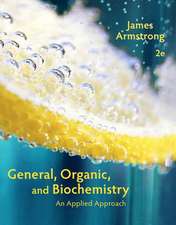The Physical Basis of Thermodynamics: With Applications to Chemistry
Autor Pascal Richeten Limba Engleză Paperback – 29 oct 2012
This book is perfect for undergraduate and graduate students who already have a basic knowledge of thermodynamics and who wish to truly understand the subject and put it in a broader physical perspective. The book is aimed not at theoretical physicists, but rather at practitioners with a variety of backgrounds from physics to biochemistry for whom thermodynamics is a tool which would be better used if better understood.
| Toate formatele și edițiile | Preț | Express |
|---|---|---|
| Paperback (1) | 958.38 lei 43-57 zile | |
| Springer Us – 29 oct 2012 | 958.38 lei 43-57 zile | |
| Hardback (1) | 972.44 lei 43-57 zile | |
| Springer Us – 31 aug 2001 | 972.44 lei 43-57 zile |
Preț: 958.38 lei
Preț vechi: 1168.76 lei
-18% Nou
Puncte Express: 1438
Preț estimativ în valută:
183.42€ • 190.98$ • 155.01£
183.42€ • 190.98$ • 155.01£
Carte tipărită la comandă
Livrare economică 10-24 martie
Preluare comenzi: 021 569.72.76
Specificații
ISBN-13: 9781461354550
ISBN-10: 1461354552
Pagini: 476
Ilustrații: XXIX, 442 p.
Dimensiuni: 178 x 254 x 25 mm
Greutate: 0.82 kg
Ediția:Softcover reprint of the original 1st ed. 2001
Editura: Springer Us
Colecția Springer
Locul publicării:New York, NY, United States
ISBN-10: 1461354552
Pagini: 476
Ilustrații: XXIX, 442 p.
Dimensiuni: 178 x 254 x 25 mm
Greutate: 0.82 kg
Ediția:Softcover reprint of the original 1st ed. 2001
Editura: Springer Us
Colecția Springer
Locul publicării:New York, NY, United States
Public țintă
ResearchCuprins
1. Entropy and Principles.- 1.1 Preamble.- 1.2 Internal Energy and First Principle.- 1.3 Tensions and Extensities.- 1.4 Entropy and Second Principle.- 1.5 Entropy and Thermal Energy.- 2. Energies and Evolution Criteria.- 2.1 Internal Energy of an Open System.- 2.2 Energies.- 2.3 Evolution Criteria and Thermodynamic Potentials.- 2.4 Stabilities and Internal Equilibrium.- 3. Auxiliary Relations.- 3.1 Differential Expressions.- 3.2 Partial Molar Properties.- 3.3 Thermodynamic Equations of State.- 3.4 Summary of Thermodynamic Relationships.- 4. Observable Properties.- 4.1 Intensive Properties.- 4.2 Volume Properties.- 4.3 Heat Capacity and Enthalpy.- 4.4 Entropy and Nernst’s Law.- 4.5 Heats of Transfomation.- 4.6 Gibbs Free Energy.- 4.7 Thermodynamic Data.- 5. Equations of State.- 5.1 Ideal Gases.- 5.2 Properties and Transformations of an Ideal Gas.- 5.3 Real Fluids.- 5.4 Real Gases.- 5.5 Condensed Phases.- 6. Configurational Changes.- 6.1 Configurations.- 6.2 Equilibrium Phase Transitions.- 6.3 Kinetic Transitions.- 6.4 Glass Transition.- 7. Criteria for Chemical Equilibrium.- 7.1 Chemical Reactions.- 7.2 Equilibria.- 7.3 Phase Separation.- 8. Equilibrium and Chemical Potentials.- 8.1 Preamble.- 8.2 Ideal Gas.- 8.3 Mass Action Law.- 8.4 Real Gases.- 8.5 Condensed Phases.- 8.6 General Equilibrium.- 9. Phase Rule and Simple Univariant Equilibria.- 9.1 Phase Rule.- 9.2 Unary Systems.- 9.3 Simple Univariant Equilibria.- 10. Binary Phase Diagrams.- 10.1 Solubility.- 10.2 Eutectic Diagrams.- 10.3 Spindle-Like Diagrams.- 10.4 Partial Solubilities.- 10.5 Azeotropes, Fractionation.- 10.6 Variations on Binary Themes.- 10.7 Pressure Effects.- 11. Solutions and Solution Models.- 11.1 Entropy in Ideal Solutions.- 11.2 Mixing and Excess Properties.- 11.3 Colligative Properties.- 11.4General Solution Models.- 11.5 Other Solution Models.- 11.6 Electrolytes.- 12. Equilibria in Electrolyte Solutions.- 12.1 Acids and Bases.- 12.2 pH Calculations.- 12.3 Ions: Standard Properties and Interactions in Solution.- 12.4 Redox Reactions.- 13. Basics of Statistical Mechanics.- 13.1 A Primer with Ideal Gases.- 13.2 State of a Microscopic System.- 13.3 Counting of States.- 13.4 Maxwell-Boltzmann Statistics.- 13.5 Applications of the Maxwell-Boltzmann Statistics.- 13.6 Quantum Statistics.- 14. Theoretical Calculations of Thermodynamic Properties.- 14.1 Energies and Partition Functions.- 14.2 Ideal Gases.- 14.3 Crystals.- 14.4 Numerical Simulations.- 15. Isotopic Equilibria.- 15.1 Isotopic Reactions.- 15.2 Reduced Partition Function Ratios.- 15.3 Isotopic Equilibria.- 15.4 Isotope Fractionation.- Appendices.- A. Mathematical Complements.- A.1 State Functions and Exact Differentials.- A.2 Relations Between Partial Derivatives.- A.3 Homogeneous Functions.- B. Adiabatic Compressibilities.- B.1 Acoustic Waves.- B.2 Fluids.- B.3 Solids.- C. Shock Waves and Equations of State.- C.1 Shock Waves.- C.2 Equations of Rankine-Hugoniot and Hugoniot.- C.3 Pressure and Volume.- C.4 Pressure, Temperature and Volume.- D. Multicomponent Regular and Subregular Models.- D.1 Regular Model.- D.2 Subregular Model.- E. Molecular Energies.- E.1 Internal and Translational Energy.- E.2 Born-Oppenheimer Approximation.- E.3 Vibrational and Rotational Energies.- References.
Recenzii
`From the first paragraph of the first chapter, this text informs the reader that he/she was lucky enough to find an excellent book to finally understand chemical thermodynamics. The level of writing is suitable for any audience whether undergraduate, graduate, or industry professional. The reader is not bombarded with overly mathematical and boring theoretical diatribe. Rather, it is as if five scientific copyeditors collaborated and approved each word as `the right way to explain things.' And, that is how the text comes across to the reader.'
Dawn Lee Wakefield, Texas A&M
Dawn Lee Wakefield, Texas A&M










